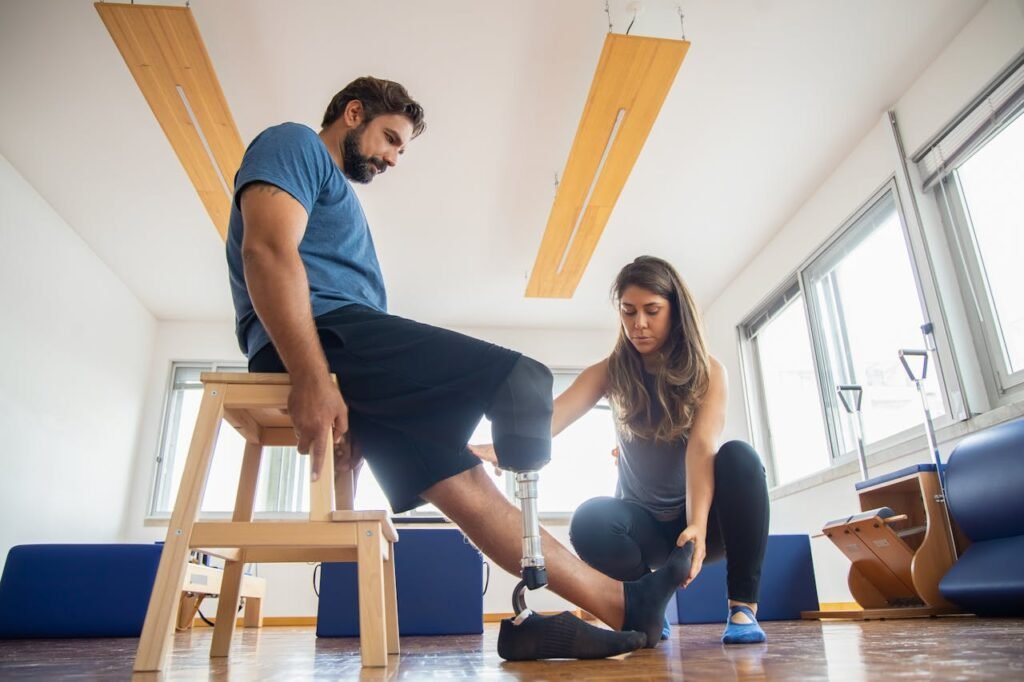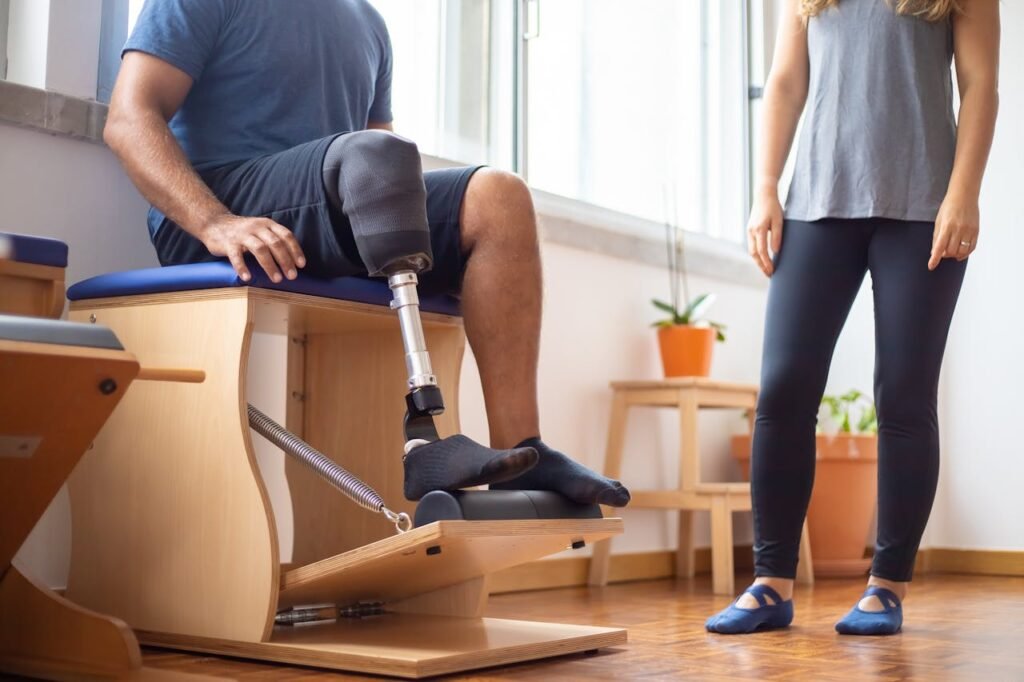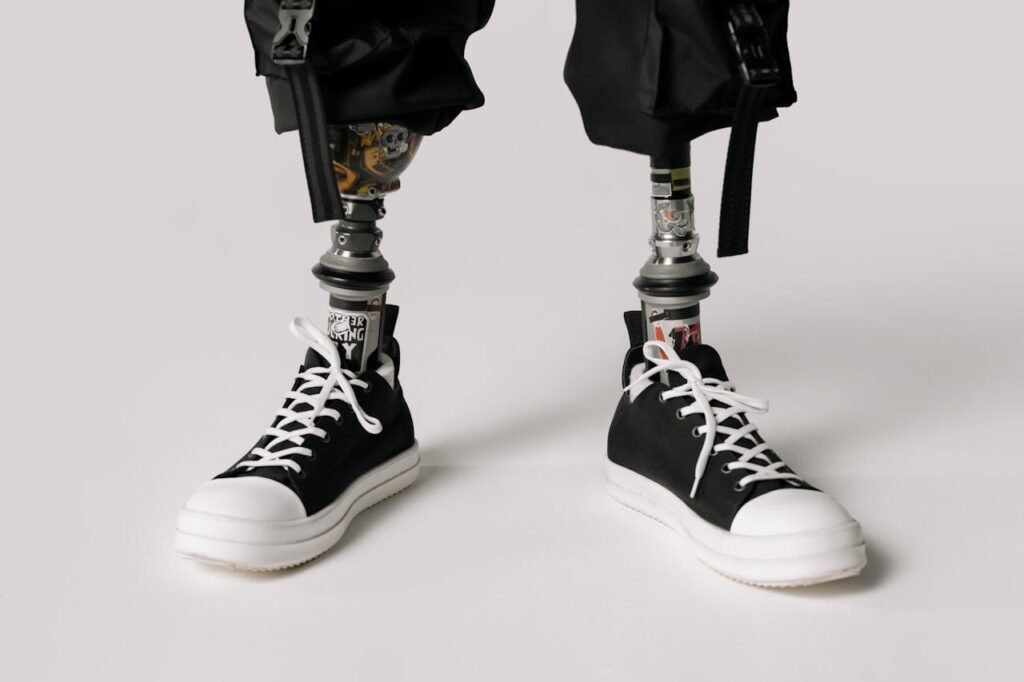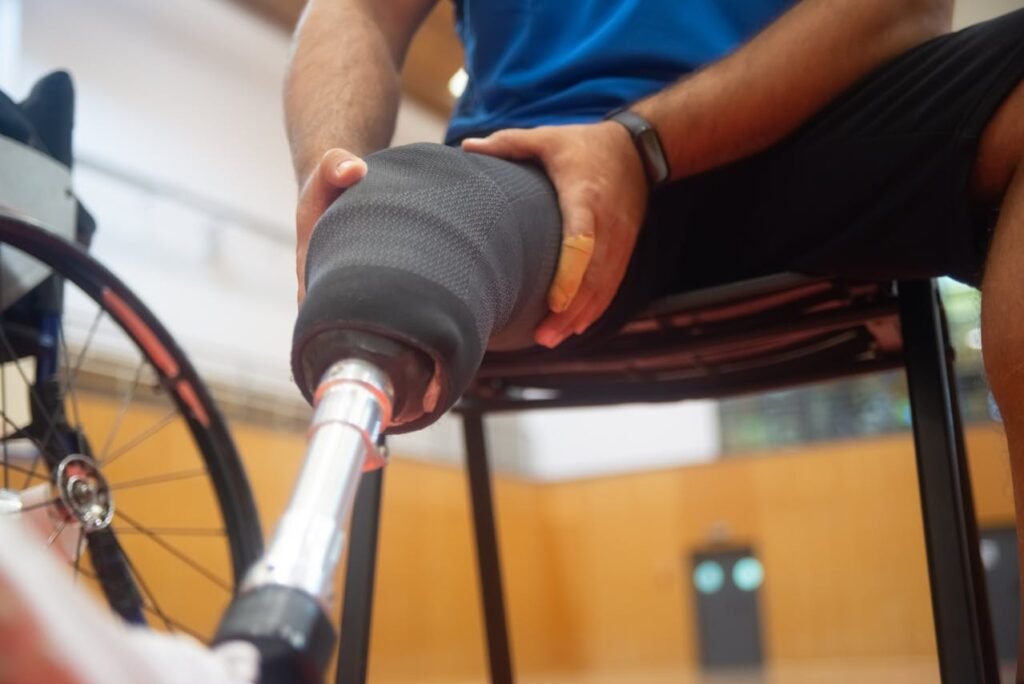When someone tries a new prosthetic for the first time, one thing matters most—comfort. It’s not about how advanced the design looks or how strong it feels. What truly defines success is how gently the socket fits your skin and how naturally it connects with your body.
At Robobionics, we believe every prosthetic journey should begin with care, not pressure. The socket—the part that touches your skin—decides everything. If it’s too tight, too loose, or irritates your skin, it can turn daily use into a struggle. That’s why our trial sockets are designed not just for testing function, but for checking sensitivity and skin health before the final fit is made.
This article takes you behind the process. You’ll learn why sensitivity testing matters, how we check skin comfort, what signs to watch for, and how to make sure your first fitting experience feels safe and right. We’ll also show how regular skin checks can protect you from long-term problems and keep your prosthetic journey smooth from day one.
Why sensitivity and skin checks come first
The foundation of a good prosthetic fit

Every prosthetic begins where your body meets the socket. That connection point is delicate. Your skin, muscles, and nerves must adapt to something new pressing, holding, and supporting your weight or motion.
If that contact isn’t right, everything else—alignment, control, even confidence—falls apart. A prosthetic that looks advanced but causes pain or redness won’t be worn for long.
That’s why sensitivity testing and skin observation come before all else. They tell us what your body can handle and how much pressure feels safe.
Listening to your skin
Your skin speaks, even when you don’t. It tells you when something’s wrong—through warmth, color changes, or a prickly feeling. We pay close attention to those signals during every trial.
You might think a little redness is normal, but it’s not always harmless. Small signs can reveal where the socket needs reshaping or padding. Acting early prevents injury and helps you build comfort faster.
More than a medical step
This isn’t just a clinical check—it’s emotional reassurance. When people try a prosthetic for the first time, fear of pain is real. Sensitive, careful fittings help build trust.
By focusing on comfort first, we help users relax, move naturally, and believe in the process. Confidence grows when pain doesn’t.
Understanding skin sensitivity
What makes the limb sensitive
After amputation, the skin around your residual limb goes through major changes. It becomes more exposed, sometimes thinner, and often more reactive to touch, heat, or pressure.
The nerves that once carried signals to your hand or leg now end in smaller, more concentrated areas. That’s why even gentle pressure can feel intense.
During a trial fitting, we test how your limb responds to contact, compression, and motion. These responses guide how we design the final socket.
How sensitivity changes over time
In the first few weeks after amputation, the skin can feel tender and uneven. With gradual training and desensitization exercises, it starts adapting to touch again.
But even months later, sensitivity can vary daily depending on temperature, activity, or health. That’s why skin checks aren’t one-time—they’re ongoing.
Our team tracks those shifts and adjusts socket fit accordingly. Comfort today must stay comfort tomorrow.
Individual differences
No two limbs are alike. Some users have smooth, soft skin; others have scars or bone prominences. Each surface reacts differently.
That’s why trial sockets are never “one-size-fits-all.” Every socket we create is personalized—shaped, lined, and adjusted based on your skin’s real behavior.
What happens during a sensitivity check
Gentle touch testing
Before we even fit the trial socket, we start with simple touch tests. Using soft materials like cotton or silicone pads, we check how sensitive different parts of your limb are.
You’ll tell us where it feels normal, ticklish, or sharp. That map helps us avoid high-sensitivity zones while designing socket contact areas.
Pressure and load tests
Next, we simulate how the limb will feel under load. Using mild compression sleeves or light weight-bearing tests, we note how your skin responds to pressure.
If you feel tingling, heat, or dull pain, we know which areas need softer materials or relief zones. These adjustments keep blood flow steady and reduce friction.
Motion and friction analysis
Once the trial socket is on, we guide you through short movements—lifting, bending, or walking, depending on the prosthetic type.
We watch for small shifts that might cause rubbing or pinching. Even tiny movements can reveal big comfort issues. Adjustments are made in real time until you can move freely.
Common skin reactions during trial fittings
Redness and warmth
Mild redness is common during early trials. It usually means your skin is adjusting to pressure. But redness that lingers or feels hot suggests irritation.
We monitor these spots carefully. A bit of extra padding or shape correction often solves it before it becomes serious.
Sweating and moisture
Many users notice more sweat inside the socket. It’s natural—your skin is enclosed and active. But trapped moisture can cause itchiness or bacterial growth.
We use breathable liners and recommend regular cleaning routines. Some users also try antiperspirant sprays designed for sensitive skin.
Pressure marks or bruising
Dark spots or deep marks mean the pressure isn’t balanced. We adjust the socket shape immediately to relieve it.
Ignoring these signs can cause blisters or skin breakdown later. The faster you tell us what you feel, the faster we fix it.
Phantom sensations
Some users feel pain or tingling even when the limb isn’t touched. These are nerve-based sensations, not skin issues. Still, they influence comfort.
We note these sensations and use soft materials that cushion nerve endings, easing the discomfort.
The role of liners and socket materials
Why liners matter

The liner is your skin’s first shield. It reduces friction between the socket and limb, spreads pressure evenly, and absorbs sweat.
We use medical-grade silicone or gel liners that adapt to skin texture. For users with high sensitivity, softer liners make a big difference.
Matching material to lifestyle
If you work in warm environments or move a lot, we recommend breathable liners. If you do heavy lifting, firmer options provide better support.
Our goal is to match your daily reality, not just your measurements. You shouldn’t have to change your routine for your prosthetic—it should adapt to you.
Cleanliness and care
A clean liner keeps skin healthy. We guide every user on washing and drying routines to prevent irritation or odor.
Simple habits—like cleaning with mild soap and drying fully before use—protect both the liner and your skin long-term.
How trial sockets help identify comfort zones
Transparent for observation
Our trial sockets are often made of clear materials. This allows clinicians to see how your skin behaves inside—where pressure builds or where space is too loose.
Visual feedback makes fitting more accurate. It’s easier to correct what you can see.
Adjustable in real time
We can reshape or trim trial sockets during the session. If a spot feels tight or pinches, we relieve that area instantly.
Small fixes now prevent big problems later. The aim is to reach a stage where the socket feels like an extension of your body, not an object attached to it.
Testing movement safely
We always encourage users to move gently with the trial socket—walking, bending, or gripping objects. This shows how comfort holds up in motion, not just at rest.
Sometimes, pressure feels fine when still but becomes painful during activity. The trial phase catches those differences early.
Checking circulation and skin color
Why circulation checks matter
Good blood flow keeps your skin strong and pain-free. If the socket is too tight, it can restrict circulation, causing numbness or color change.
We look for early signs—bluish skin, swelling, or coldness. These are warning signals to adjust fit immediately.
Simple tests we do
During fitting, we may ask you to remove the socket after a few minutes. We’ll check how quickly your skin color returns to normal. Fast recovery means healthy circulation.
If redness stays longer than 20 minutes, we ease the pressure points and retest. The goal is a snug fit without strain.
What you can do at home
After your trial, we teach you how to do mini skin and circulation checks yourself. Look at your limb after use. If any area feels cold, numb, or stays red too long, stop wearing the prosthetic and contact your clinician.
Monitoring daily helps you catch problems before they grow.
The importance of communication during fittings
You are the expert of your body
No one knows your comfort better than you. We rely on your feedback—every comment, every sensation—to perfect your fit.
Don’t hesitate to speak up during a trial. Even a small “this feels warm” or “this area tingles” helps us make important adjustments.
Creating a safe dialogue
Our team listens without rushing or judging. Your comfort shapes every decision. We never force you to continue if something feels wrong.
That open communication builds trust. It turns a technical process into a partnership.
Documenting progress
We record all feedback, even small details, after each fitting. These notes guide future adjustments and create a clear comfort history for you.
By the final fitting, the result is a socket made not just from measurements—but from shared understanding between you and your prosthetist.
Skin care routines before and after fittings
Pre-fitting preparation
Clean, dry skin is less prone to irritation. Before every fitting, wash your limb with mild soap and water, then pat it dry.
Avoid applying thick creams or oils before putting on your liner—they can trap heat and moisture.
After fitting care
Once the socket is removed, gently clean your limb again. Inspect for redness, spots, or irritation. If you notice anything unusual, let us know before your next trial.
Applying a light, fragrance-free moisturizer at night helps skin recover and stay supple.
Long-term skin resilience
Healthy skin adapts better to prosthetics. Eating well, staying hydrated, and avoiding friction during daily use all help.
We also recommend short “rest breaks” during long prosthetic wear. Removing the socket for a few minutes lets your skin breathe and reset.
When adjustments are necessary
Recognizing early warning signs
Pain, pinching, or burning sensations are red flags. So are deep marks, persistent redness, or swelling. These signs mean your socket needs modification.
Don’t wait for it to worsen. The earlier we fix it, the easier it is to restore comfort.
How adjustments are made
We may heat and reshape small sections, add extra padding, or change liner thickness. Sometimes, a new cast is taken for improved symmetry.
Each change is small but significant. Comfort grows step by step, guided by your feedback.
Follow-up schedule
Even after your final socket is ready, we schedule regular reviews. The body changes with time—muscle tone, limb size, or skin condition can shift.
Routine checks ensure your fit stays as good as day one.
Long-term comfort maintenance
The reality of daily wear

After you start using your final prosthetic, real-life comfort becomes a day-to-day journey. Your limb changes shape slightly with temperature, activity, and time of day. That’s why what feels perfect in the morning can feel snug by evening.
We teach users to recognize these small variations instead of ignoring them. A quick rest, a readjustment of the liner, or loosening the socket briefly can restore balance. Awareness prevents discomfort before it turns into injury.
Regular professional reviews
Even when everything feels fine, we recommend check-ups every few months. During these visits, we inspect your socket, liner, and skin condition. Small tweaks often make big differences.
If you’ve lost or gained weight, or if your skin texture has changed, a re-fit might be needed. The body is living and changing—your prosthetic should follow its rhythm.
Keeping equipment fresh
Every material, no matter how strong, ages over time. Liners stretch, sockets polish down, and padding compresses. Cleaning regularly and replacing worn parts keeps your setup safe.
We encourage every user to think of their prosthetic like a pair of running shoes. It performs best when maintained with care and replaced when tired.
Managing pressure safely
The balance between snug and tight
A well-fitted socket should feel secure but never restrictive. If it feels tight enough to cut circulation or cause numbness, it’s too much. If it feels loose and slips, you’ll experience rubbing that can hurt over time.
Our aim is always balance—enough grip for control, enough freedom for comfort. It’s a partnership between technology and your body’s signals.
Adapting to daily changes
Humidity, activity level, or even what you eat can slightly change your limb’s volume. Some users prefer keeping two liners of different thicknesses—one for cooler mornings and one for warmer, swollen afternoons.
We teach you how to sense when a swap or small change helps. This independence ensures your comfort doesn’t depend on clinic visits alone.
Relieving high-pressure spots
If a small area repeatedly feels sore, that’s your body asking for help. We identify such zones with pressure-mapping tests. Once we see where the stress concentrates, we relieve it with trimming, contouring, or liner layering.
It’s not trial and error—it’s careful sculpting guided by your feedback and science.
Emotional confidence and adaptation
Rebuilding trust in your body
Wearing a prosthetic is not only physical—it’s deeply emotional. Some people worry every new movement will hurt or cause marks again. That hesitation is natural but fades with gentle progress.
When fittings go smoothly and skin feels safe, trust returns. Each pain-free day tells your mind: “This is part of me now.” That quiet acceptance unlocks full confidence.
Overcoming fear of pain
Many new users still carry memories of earlier fittings or ill-fitting devices. We take time to rebuild comfort emotionally as well as physically. No one is rushed or judged.
We remind you that pain is not normal. The absence of pain is the new goal—and it’s fully achievable. Once you believe that, the process feels lighter and more empowering.
The confidence to live freely
Comfort creates confidence. When you don’t have to think about your limb, you can focus on your work, your hobbies, your relationships.
Our proudest moments come when users say, “I forgot I was even wearing it.” That’s the true sign of success—a device that disappears into your daily life because it simply feels right.
The clinician’s role in long-term comfort
Partnership beyond fitting
At Robobionics, our relationship with users doesn’t end after delivery. Your clinician remains your guide for months, sometimes years.
We believe in follow-up, not follow-through. Each check-up is a conversation—how your skin feels, how your routine evolved, what challenges emerged. These details help us keep your prosthetic tuned to your real life.
Training and adaptation support
Our prosthetists work with physiotherapists and occupational therapists to design personalized comfort exercises. These include gentle stretches, balance drills, and desensitization techniques.
Together, we make sure your muscles support the socket evenly and your skin stays flexible under daily pressure.
Transparent guidance
We explain every adjustment clearly. You’ll know what’s being changed, why it’s needed, and what difference it makes. Transparency builds trust—and that trust makes care consistent and effective.
Home routines for lasting comfort
Daily inspection
Before and after wearing your prosthetic, check your limb under good light. Look for redness, swelling, or unusual dryness.
Running your fingers lightly over your skin helps detect hidden soreness. The sooner you catch issues, the faster they heal.
Clean and dry habits
Always start with clean, dry skin. Sweat trapped under the liner invites irritation. If you work outdoors or in heat, take short breaks to remove the prosthetic and let your skin breathe.
At night, apply a mild, fragrance-free moisturizer. Let it soak fully before bed. Soft, healthy skin tolerates pressure far better than dry, cracked skin.
Rest and variation
Your skin, like any muscle, needs rest. Short breaks throughout the day prevent overuse. If your job demands long hours, try to remove the prosthetic during lunch or quiet periods.
Rotating between different liners or socks can also reduce friction and pressure concentration.
Building awareness through education
Teaching the small signs

We train every user to recognize the earliest signs of discomfort. If an area stays red beyond 20 minutes or feels warm after removal, it needs attention.
This small awareness saves weeks of trouble later. Prevention is always better than treatment.
Educating caregivers and family
Family support strengthens success. We involve caregivers in every session—showing them how to assist with cleaning, donning, and daily checks.
When loved ones understand the process, anxiety drops, and motivation rises. They become partners in progress, not bystanders.
Sharing knowledge with new users
Experienced users often become mentors for newcomers. They share practical advice—what helped, what didn’t, and how to stay positive through adaptation.
Community learning turns prosthetic use into a movement of mutual support, not an individual struggle.
Research and technology for better skin comfort
Smarter materials
Modern prosthetic materials now respond to temperature and moisture. Some liners adapt firmness based on skin warmth, staying soft when needed and firm when active.
We continuously test these innovations in India’s climate, ensuring they suit both humidity and heat. Comfort here needs more than imported solutions—it needs local adaptation.
Sensors for real-time feedback
Emerging designs include sensors that track socket pressure and skin temperature. If something feels wrong, the prosthetic alerts both user and clinician through an app.
Such systems will make comfort measurable, not just felt. Robobionics is exploring these tools for future models to make proactive care the norm.
Personalized socket printing
3D scanning and printing allow sockets to match every contour of your limb precisely. Unlike traditional casting, it captures even minor variations, reducing pressure unevenness.
Combining this with flexible, breathable materials offers a truly next-generation comfort experience.
The future of comfort-driven prosthetics
Shifting priorities
For years, prosthetics focused on movement and strength. Now, the focus is shifting to comfort and skin health. Because true mobility isn’t about power—it’s about sustainability.
We’re proud to be part of this shift, building technology that listens to the body instead of forcing it to adapt.
Comfort as technology’s new benchmark
Our Sense of Touch technology was born from that belief. It doesn’t just help control the prosthetic; it reduces the subconscious pressure people put on their sockets.
By teaching users how much force is “just right,” we prevent overgripping, reduce stress, and protect skin without sacrificing performance.
Making comfort affordable
Comfort shouldn’t be a privilege. We design high-quality sockets and liners that are made in India but meet global standards. That lowers costs while keeping durability high.
Every step toward affordability expands access—and access means more people living without pain.
next step
Comfort begins with awareness
Your skin is your best teacher. Listen to it, respect it, and act early when it sends a signal.
Experience comfort firsthand
Book a free prosthetic trial with Robobionics and see how personalized fittings make every step painless and secure. Visit www.robobionics.in/bookdemo.
Our promise
We build more than prosthetics—we build comfort you can trust. With care, precision, and empathy, we ensure every user feels at home in their own body again.



